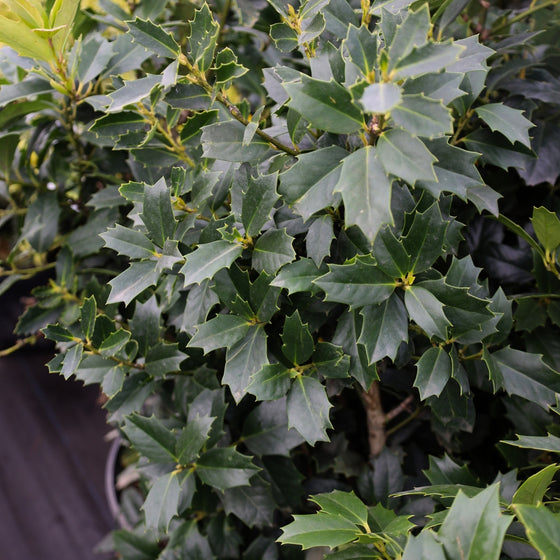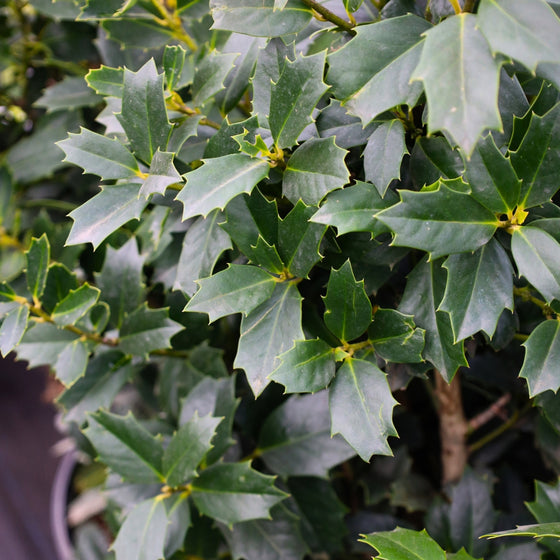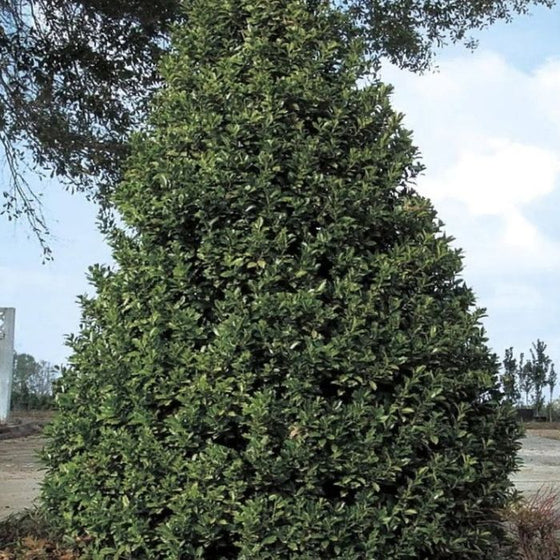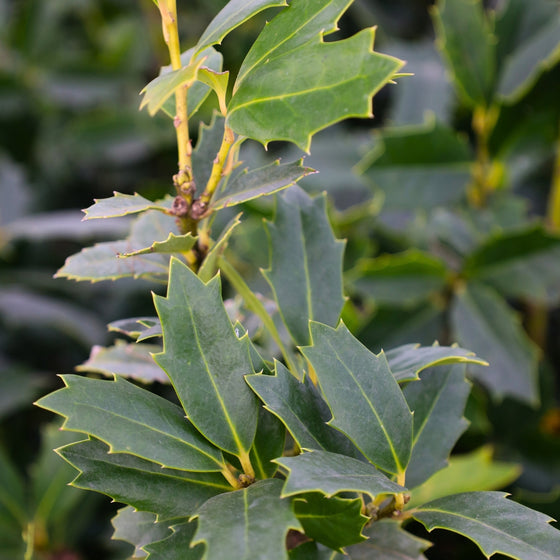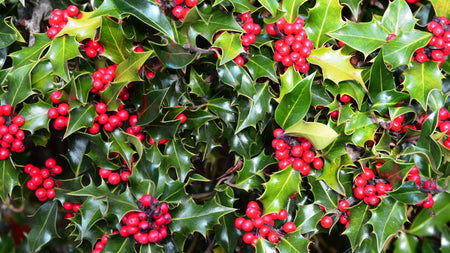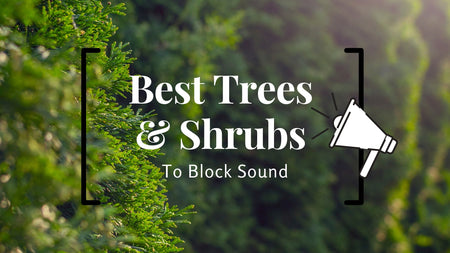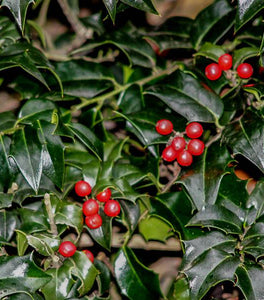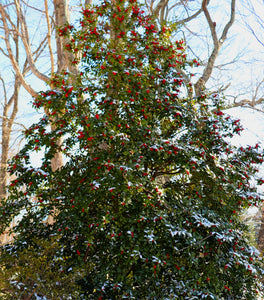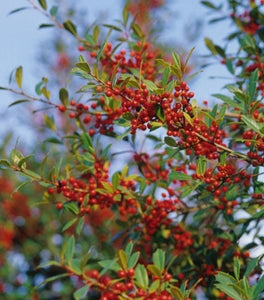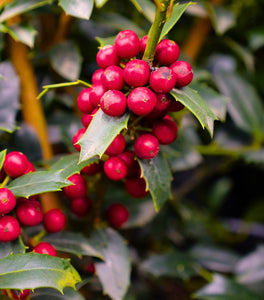
Images Depict Mature Plants
Oakland Holly Trees for Sale Online
Oakland Holly (Ilex x ‘Magland’) is a striking evergreen shrub known for its dense, pyramidal form and glossy, dark green foliage. Unlike traditional holly varieties, Oakland Holly features distinct oak-shaped leaves that add unique texture and visual interest to the landscape. The tree produces small, bright red berries in the fall and winter, providing a pop of color and attracting birds to your garden. Reaching a mature height of 15 to 20 feet with a spread of 12 to 15 feet, Oakland Holly is perfect for a privacy screen, accent tree, or foundation planting, offering year-round beauty and elegance.
Ideal for USDA hardiness zones 6 through 9, Oakland Holly thrives in full sun to partial shade and is adaptable to various soil types as long as the soil is well-drained. Its moderate growth rate and naturally symmetrical shape make it a low-maintenance option for both formal and informal gardens. Oakland Holly’s dense foliage makes it an excellent choice for creating a living barrier or windbreak, providing year-round privacy without excessive pruning. The bright red berries contrast beautifully against the dark green leaves, adding festive interest to your landscape during the colder months.
In addition to its ornamental appeal, Oakland Holly is also known for its resilience. This holly variety is deer-resistant and resistant to many common pests and diseases, making it a reliable choice for gardens where browsing is a concern. To establish Oakland Holly, water it regularly during the first growing season to help develop a strong root system, and apply a layer of mulch around the base to retain moisture and suppress weeds. Once established, this hardy evergreen can tolerate periods of drought and requires minimal maintenance, making it an attractive and dependable addition to your garden year-round.

| Hardiness Zone: | 6-9 |
|---|---|
| Mature Height: | 15 to 20 feet |
| Mature Width: | 12 to 15 feet |
| Sunlight: | Full sun to part shade |
| Foliage Color: | Dark green |
| Growth Form: | Upright pyramidal |
| Soil Conditions: | Very tolerant of most soil conditions, likes acidity |
How to Care for Oakland® Holly
Be sure to read our planting instructions to ensure a healthy and happy Oakland Holly Tree for years to come!
How do I plant my Oakland Holly Tree?
Planting an Oakland Holly tree begins with selecting the right location to ensure healthy growth and vibrant foliage. Choose a site that offers full sun to partial shade, as this will help the tree develop its signature dark green leaves and produce an abundance of bright red berries. Oakland Holly prefers well-drained, slightly acidic soil, so be sure to avoid areas where water tends to collect. Start by digging a hole twice as wide and as deep as the root ball to give the roots ample space to spread. Place the tree in the hole, ensuring the top of the root ball is level with or slightly above the ground. Backfill with a mixture of native soil and organic compost, gently firming the soil around the roots. After planting, water thoroughly to help settle the soil and establish good root contact. To ensure the success of your Oakland Holly tree, regular watering during the first growing season is crucial for developing a strong root system. Water the tree deeply once or twice a week, depending on weather conditions, to keep the soil consistently moist but not waterlogged. A 2-3 inch layer of mulch around the base of the tree will help retain moisture, regulate soil temperature, and suppress weeds, but keep the mulch a few inches away from the trunk to prevent rot. If planting multiple Oakland Holly trees for a hedge or privacy screen, space them about 6 to 8 feet apart to allow for their mature spread while ensuring sufficient airflow. With proper planting and early care, your Oakland Holly will establish itself as a beautiful, low-maintenance evergreen that enhances your landscape year-round.
How do I water my Oakland Holly Tree?
Watering your Oakland Holly tree properly is crucial to support healthy growth and maintain its glossy, dark green foliage. During the first growing season, it is important to water deeply and consistently, about once or twice a week, depending on rainfall and soil conditions. Deep watering encourages the roots to grow deeply into the soil, which helps the tree establish a strong root system and improves its drought tolerance over time. Water the tree at the base, ensuring the entire root zone is moistened but avoiding waterlogging, as Oakland Holly prefers well-drained soil. Using a soaker hose or drip irrigation system can help deliver water slowly and efficiently, reducing runoff and ensuring that moisture reaches the roots. Once your Oakland Holly is established, it becomes more tolerant of dry conditions but still benefits from supplemental watering during extended periods of heat or drought, particularly in the summer months. Always check the top few inches of soil; if they feel dry, it’s time to water deeply again. Mulching around the base of the tree can help retain soil moisture, regulate temperature, and reduce evaporation. Apply a 2-3 inch layer of mulch, but keep it several inches away from the trunk to prevent rot. Avoid shallow, frequent watering, as this can lead to weak surface roots that are more susceptible to stress. Instead, opt for deep, thorough watering practices to support a healthy, thriving Oakland Holly tree that remains vibrant and lush throughout the seasons.
How do I fertilize my Oakland Holly Tree?
Fertilizing your Oakland Holly tree is essential for promoting lush, dark green foliage and supporting berry production. The best time to fertilize is in early spring, just before new growth begins, using a balanced, slow-release fertilizer specifically designed for acid-loving plants. A 10-10-10 or 12-4-8 fertilizer works well, providing the essential nutrients that Oakland Holly needs for vigorous growth. Apply the fertilizer evenly around the root zone, extending out to the tree's drip line, but be sure to keep it at least 6 inches away from the trunk to avoid root burn. After fertilizing, water thoroughly to help the nutrients penetrate the soil and reach the roots effectively. For continued nourishment, you can fertilize your Oakland Holly again in early summer if it shows signs of slow growth or yellowing leaves. In addition to chemical fertilizers, organic options like compost or aged manure can be applied to enhance soil fertility naturally while improving soil structure. Mulching around the base of the tree not only helps to conserve moisture but also gradually enriches the soil as it decomposes, providing a continuous source of nutrients. Avoid fertilizing late in the growing season, as this can encourage new growth that may not harden off properly before winter, making it susceptible to cold damage. By following these fertilization practices, your Oakland Holly tree will thrive, showcasing its signature glossy foliage and vibrant berries throughout the year.

How do I prune my Oakland Holly Tree?
Pruning your Oakland Holly tree is an important part of maintaining its dense, attractive shape and encouraging healthy growth. The best time to prune is in late winter or early spring before new growth begins, as this minimizes stress on the tree and helps direct energy to the new shoots. Begin by removing any dead, damaged, or diseased branches, cutting them back to healthy wood. This helps improve airflow throughout the tree and reduces the risk of pest infestations and fungal diseases. Use clean, sharp pruning shears to ensure precise cuts, and trim branches just above a bud or side branch to promote healthy new growth. The natural pyramidal form of Oakland Holly makes it easy to shape, requiring only light pruning to maintain its desired appearance. When pruning Oakland Holly, it’s important not to cut too deeply into old wood, as new growth may not regenerate from mature branches. Focus on trimming back any overly long or wayward branches to keep the tree compact and well-formed, particularly if using it as part of a hedge or privacy screen. For a formal hedge, light annual pruning will help maintain a uniform shape and keep the hedge dense. Avoid heavy pruning in late summer or fall, as this can stimulate new growth that may not harden off before winter, leaving it vulnerable to cold damage. By following these pruning techniques, your Oakland Holly tree will stay healthy, maintain its glossy green foliage, and provide an abundance of bright red berries that add beauty and interest to your garden year-round.

